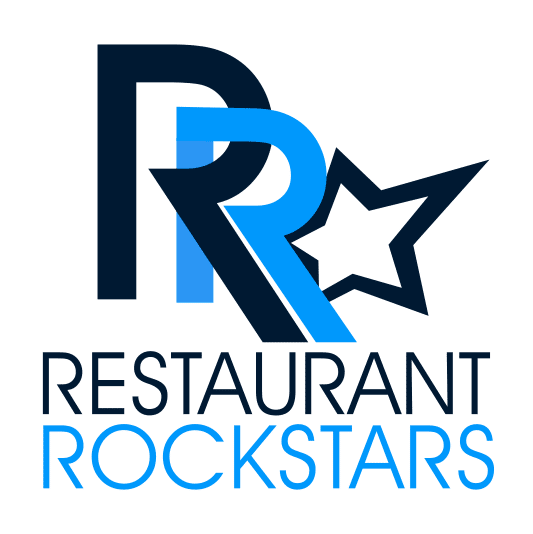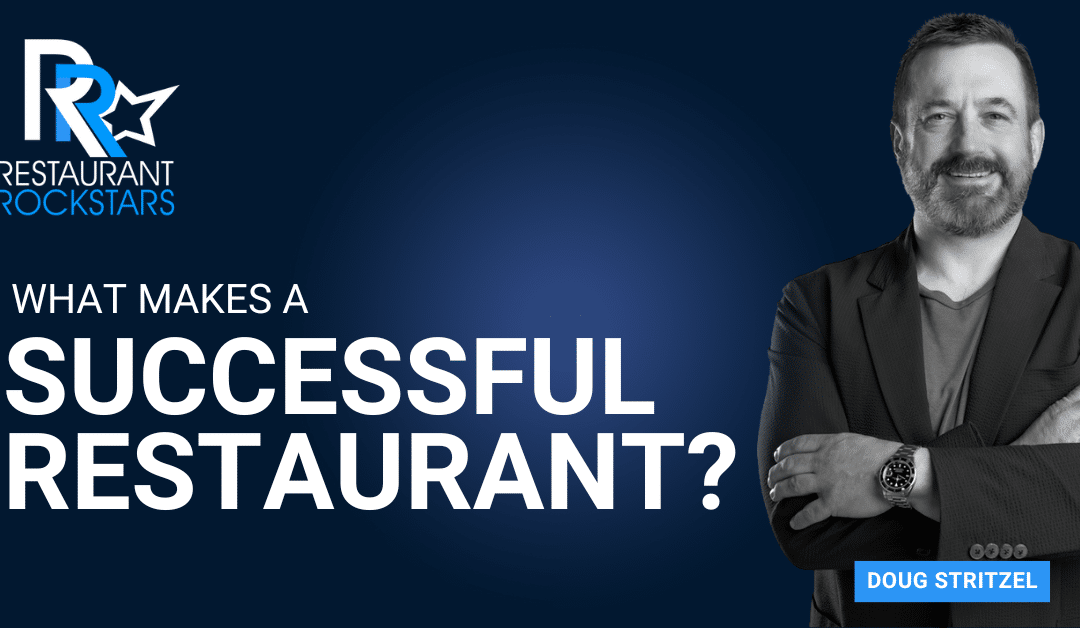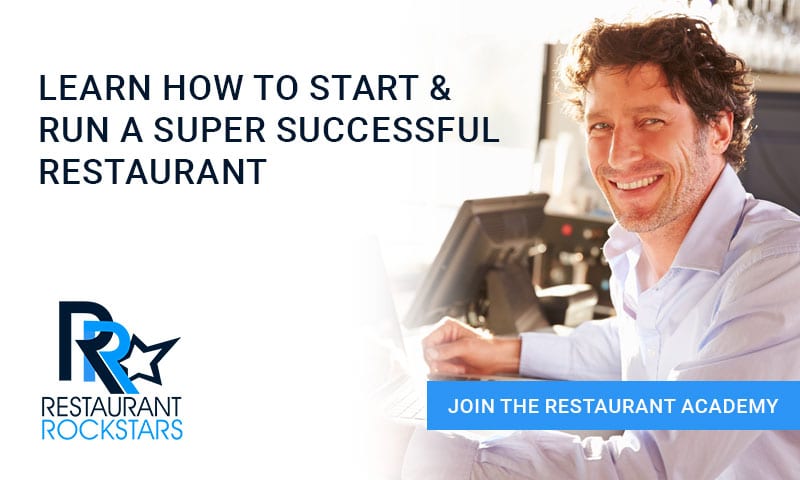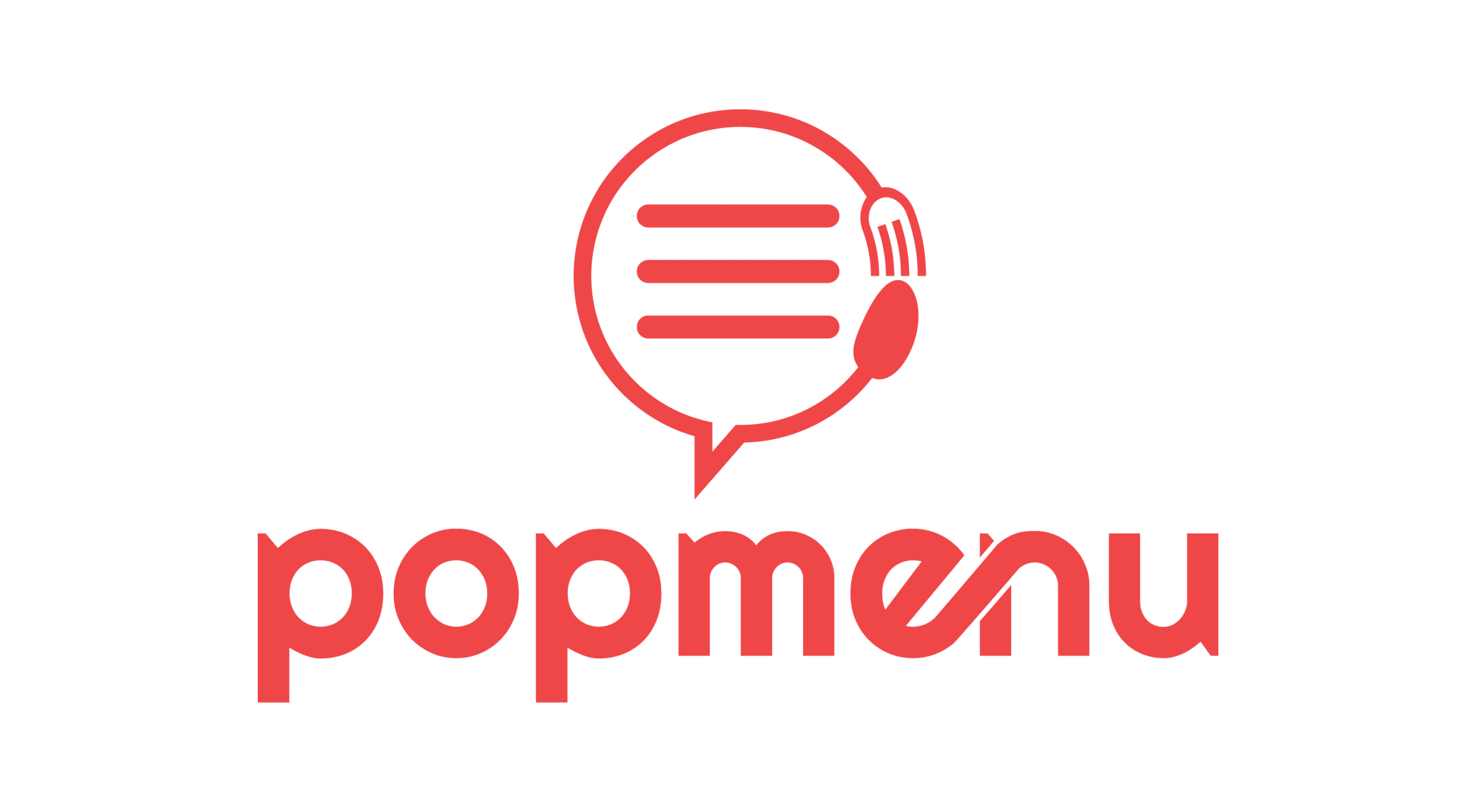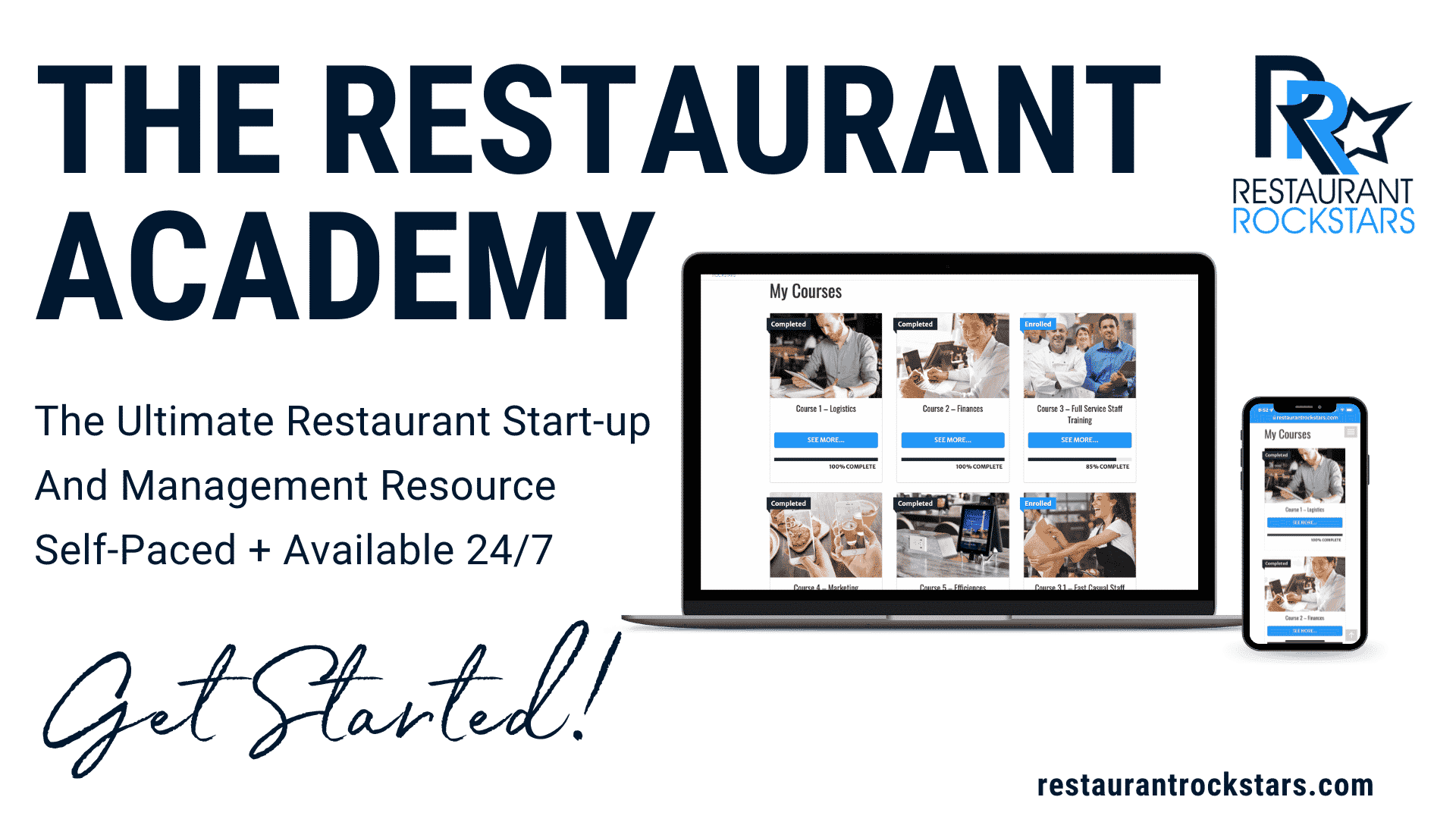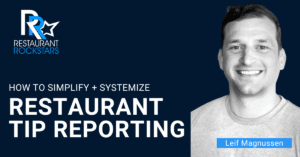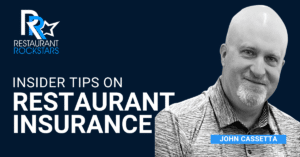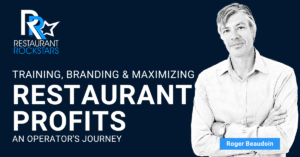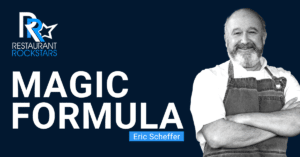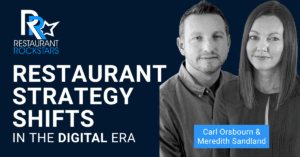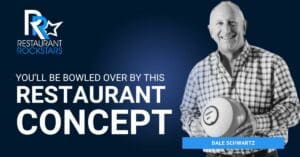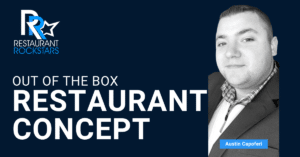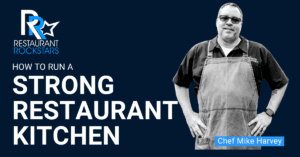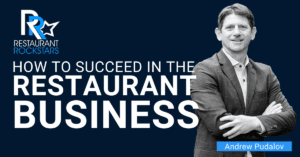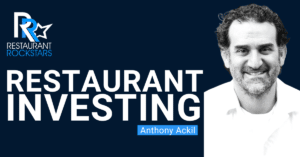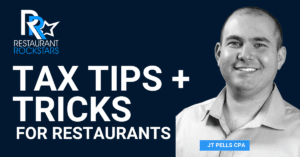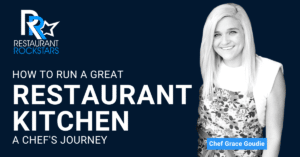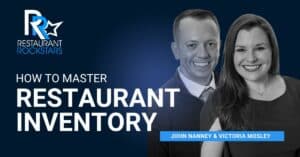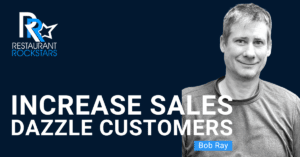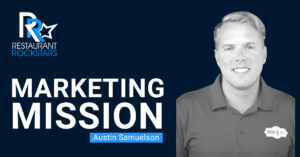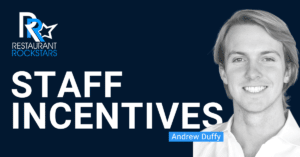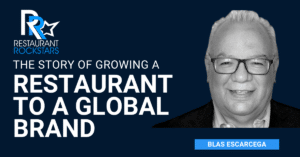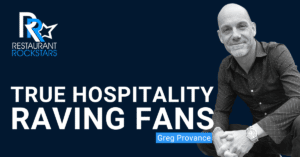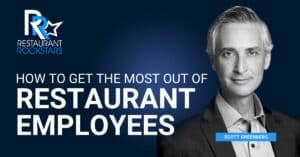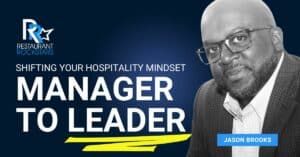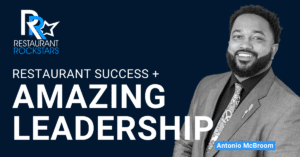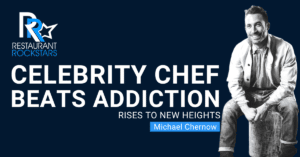Restaurant Rockstars Episode 372
What Makes a Successful Restaurant?
LISTEN HERE OR ON YOUR FAVORITE PODCAST PLAYER
All successful restaurants have a secret formula.
It might be about the food, or the relationships between owner, staff & guests. Perhaps it’s the marketing, or the location.
Sometimes it’s a combination of all of these.
How can your restaurant be more successful? Listen on!
In this episode of the Restaurant Rockstars Podcast, I’m speaking with Doug Stritzel – the Founder of Pickleman’s Gourmet Cafes.
Listen as Doug shares all about what makes a successful restaurant including:
- Experience and key-learnings gained from other leading brands that built his restaurants.
- Early challenges to ultimate restaurant success
- The secret sauce of successful restaurants
- The importance of valuing and empowering staff to combat the labor crisis.
- Efficiencies and throughput for guest satisfaction and profit
- Regularly tracking finances and the key performance indicators (KPIs) that matter most.
- Rewards, loyalty programs and marketing that works.
- The key to an effective social media program
And Doug’s advice if you wish to grow your restaurant brand to multiple locations.
Don’t miss this episode, then go out there and Rock YOUR Restaurant!
Roger
Connect with our guest:
On social we are @Picklemans
https://twitter.com/Picklemans
https://www.instagram.com/picklemans/
We’ll talk about loyalty and rewards and marketing that works, leadership, accountability, staff training, onboarding. All those things. And if you want to grow from a single location to several locations, it’s about that too. So you’re not going to want to miss it. If you haven’t already, head on over to restaurantrockstars.com/profits. I’m giving away the top three ways you’re killing your restaurant profits. It’s a super eye opener. It’ll give you actionable ideas that you can implement. to improve, of course, your restaurant profit, plus a special bonus that you’ll also find super helpful. So again, head on over.
Thanks to our sponsors this week. Now, on with the episode.
You’re tuned in to the Restaurant Rockstars Podcast. Powerful ideas to rock your restaurant. Here’s your host, Roger Beaudoin.
Listen from one restaurateur to another, and I hope you GMs out there listening as well are paying attention. Marketing should never be an experiment. Oh, I tried this or I tried that. No. Any of your valuable dollars that you spend on marketing should absolutely be trackable. You should know exactly.
Where the business is coming from and that it’s driving return On your investment, you spend a certain amount of money, you wanna make far more money in return from that marketing if you can track it. So pay attention. My friend Dyson runs a business called The Birthday Club and his program is done for you because we know that everybody dines out on their birthday.
It’s a tradition, it’s a celebration. But not only do they not come in by themselves, they bring many friends with them. They usually have free spending and large check averages. It’s very profitable business. So why leave it to Chance? Why let your competitors get all the birthday business? So again, the Birthday Club is a done for you program.
All you have to do is check out www.jointhebirthdayclub.com/birthdayRockstar It’s a great program. If I still owned and operated restaurants today, after decades, it’s something I would definitely be doing, check it out. www.jointhebirthdayclub.com/birthdayRockstar
Rockstars, the busiest time of the year is coming. Is your staff ready for the holiday rush? This year, give your team the gift of PopMenu AI Answering, a simple solution for phones ringing off the hook. AI Answering handles calls 24/7, 365 days a year, so your staff can focus on in person guests.
Customize your greetings and responses. Answer common questions. promote specials and events, and send follow up links to ordering and reservations. AI answering handles it all, while escalating more complex conversations back to your team. Now, never miss another tasty revenue opportunity. Popmenu is the marketing technology platform designed to make growing your restaurant easy Discover more A.I. restaurant tools that turn your to do list into an already done list. Request a demo today and my listeners for a limited time will get $100 off their first month, plus lock in one unchanging monthly rate. Go now to popmenu.com/rockstars. Again, get $100 off your first month at popmenu.com/rockstars.
Hey, Doug, welcome to the show today.
How are you? Doing great. Thanks for having me, Roger.
Really exciting. You’ve got a very interesting background, Doug, but before we dive into all of that let’s go back to the very beginning and hospitality. Did you ever work in restaurants as a young person?
Like, how did you get in the hospitality space originally?
Interesting story. I guess that’s an interesting story. The first time I worked in a restaurant was actually at when I was a kid, my mom would drop me off at the for swim lessons and then I’d hang out at a swimming pool all day in Springfield, Illinois, my brother and I she was a single parent.
My folks got divorced, but she dropped us off at the swimming pool. We, we did the swim team and then after the swim team, we’d hang out there for about an hour or so before the pool opened and there was a little snack bar that served tombstone pizzas, hot dogs, and pretzels. The typical fare you get at a, at a.
public or actually it was a little private pool, but nonetheless, they needed help in the they needed help in the little concession stand. I was an eager young man and had already had some experience making some money at that point by picking up rotten apples in my yard so I could get an ice cream cone.
But so I worked there. I made about $2.35 an hour, but. Even then at that age, when the tombstone pizza was cooking in the little oven I, about halfway in between I’d check it and then I’d always spin it because I wanted to make sure that customer had it was important to me that it was as good as it could be.
sO I get it so brown, just right. And then then when I did a hot dog, it was crazy. They throw you in jail if you, if they do this to a kid, but I used to put the hot dog on the grill and I would slice the hot dog down the middle so I could flip it over and get a little good little sear in the middle of the hot dog.
So just just really had a kind of a knack and a passion. I love food. I just had an inherent desire to make sure that whatever it is I was providing in that little snack bar at that point, was a good experience for whoever bought that 2 hot dog or whatever it was. I can’t remember, but that was my first, that was really my first introduction to any kind of food service.
So
then you got more serious because you’ve had quite an illustrious career with some of the leading brands in this country, if not the world. How did that all begin? What was the stepping stone to that?
Again, I was in college, so trying to figure out my path in life, but at the same time, again, I still, I enjoyed food.
And, back then I had some friends, and things that would work in restaurants. I just noticed that they weren’t treated all that well, a lot of the, a lot of the owners back then, they’d be stressed out about, the volume or whatever the things that they could, they just didn’t have a lot of coping skills and there wasn’t a lot of culture around probably to help them through that.
I it’s some of The, just the lack of culture and the lack of a team environment. It to me it, I saw an opportunity because I believe that I could build a better team and although it can be intense or pressure running a restaurant, I knew that, through teamwork and, the pop, the proper culture, the proper environment, I felt like I could build a build a, Solid team of people that could accomplish some pretty good things within the restaurant without yelling then pe then could you imagine if if you had a restaurant full of people that were, everybody actually enjoyed working there and they’re working together and, there wasn’t screaming and shouting matches every night.
Who could have thunk it that that, that would create a better environment and, and I believe in a lot of cases it tends to lead to higher sales and more success. I would absolutely
agree with you. Now we’re talking about two different things and it’s a paradigm shift because a lot of businesses or companies in general have a mission and that’s what they believe should happen.
versus the company culture that you’re talking about, where everyone feels the vibe of the place, they enjoy working together, and we’re all on the same mission. We agree that it’s all about serving the customer and having your point of pride, where you want to serve everything as perfectly as you can, with true hospitality.
But there’s a huge difference there, but I think what we’re really talking about is leadership, and I know you believe in leadership, so can you tell us about your leadership philosophies and how you institute that across, your
growing chain? Yeah. I don’t know what ways back. I read the book many books.
One of the ones that really stuck with me was Stephen Covey’s seven habits and, in, highly effective people with seven habits of highly effective people. So in that book, my biggest takeaway was you can teach a man or you can give a man a fish and feed him for a day.
Or you can teach them how to fish and feed them for a lifetime. My leadership style really is just to empower people to be able to accomplish the tasks that they have at hand, and have fun while they’re doing it. We have to have fun with what we do and I think that throughout the brand that I have now, Pickleman’s the food is good.
People feel. People feel really good about the product. Then you package that in an environment where, we have a I call it 80/20 rule. Actually, when I teach it, I actually call it, it’s about the 95/5 rule. You hit. Your management teams, your leaders within the restaurant, they really need to have, they need to have their head on a swivel, but what they need to be finding and what they need to be focusing on are the little things, the little details, specific details that are going well.
Recognize those details, in, in a nice way. Say, hey, that’s a great wrap, John , you recognize those specific details. Yeah. And then that’s what guarantees that type of performance continues to happen. And what it also does too, as you’re giving, as you’re giving them all that positive feedback, is that’s, that builds up their emotional bank account with all these positive, interactions between you or between the manager and the employee.
Depending on, what, at what level and where we’re at. And the whole relationship, but that builds that emotional bank account up and in, in a comfort level. Whereas, when you see an opportunity and that’s how we call it in our company, we call it an opportunity.
We don’t call things that, that’s back to like kind of the fabric of the culture. They say you give positive feedback and corrective feedback. I don’t call it corrective feedback. I call it, Hey, we found an opportunity. So we’re working on the opportunity a little bit. That way, it’s really trying to use the language in a positive, always in a positive way or a positive direction.
We have fun while we’re doing it.
I love the three words. I really love what you said. Empowerment, opportunity, and fun. Because I think those three things combined, and I’m sure it’s happening in your organization, that it’s leading to longevity and lower turnover, but creating opportunity for people means you’re rising them up in your organization, giving them additional responsibility, showing them that opportunity, but then not criticizing negative performance, but giving them chances to make mistakes, showing them the right way, and then incentivizing them for top performance.
Is that happening in your organization? Is that how you’d sum it up? I, yeah, that’s how I’d sum it up and you know that I call that just being a coach.
Oh, that’s great. Yes. Yes. Every leader should coach and recognize talent in others and then give them additional responsibility. And not everyone wants additional responsibility.
Some people may be A players in that job. They’re perfectly happy in that job, and there’s nothing wrong with that. But then recognizing those people that just have a Passion for the business they want to learn. And you can see that when certain people really what they’re doing. And then you ask them, would you like to keep growing in this organization?
And if they say yes, it’s they don’t want to let you down. And they take that point of pride. And it’s amazing where people can go in this business without even a formal education, just having that belief in what, their confidence level having a mentor or a coach like you and the people.
In your leadership positions. It’s amazing how you can grow a business that way. And I know that’s what you’ve done because you’ve been able to scale your business. Let’s talk about the vision and the brainchild for Picklemans because we haven’t mentioned this yet, but you were the chief operating officer of Jimmy John’s.
You’ve got, obviously, experience with Tim Hortons and with Wendy’s. Again, these really leading brands. And I’m sure you learned incredible operating procedures from that, but then you also took your own. I think this is missing and this is what we could do better. But let’s talk about the vision in the brainchild and how your whole business started.
Pickle’s the purpose really when I started, I took all that experience from the past and and I really was you, I looked around and as a consumer, there really wasn’t a place where you could go and, you could really cut. You could really expect no matter what you got, you were going to get something that was really good.
The first thing really with my brand was to take whatever it is we serve, it’s got to come through my palate, and it’s got to be a good experience for me. And then with that, it also has to be healthy enough that I would want to serve it to, my mom or my grandma or my kids. Tastes good, healthier food.
And in a fast and in a fast delivery. Because, really to be successful in this business you have to understand throughput. So if you have the quality product. That tastes great. And then you can execute it and you put that in a really nice environment where people are having fun, high fiving and winning.
I think those are pretty much the combinations for success that I was, the vision that I was looking to go towards.
Now, I know you’re a big believer in systems and now we’re talking about throughput and that’s all about efficiency. And how do we serve each customer with consistency, but quickly so that obviously we can optimize our sales and, lead to success while delivering a consistently great experience.
But that, that involves so many details along the way. And I know you mentioned that you’re all about clean, responsible, healthy food products that you’re bringing into the restaurants. Does that mean that the prep. Procedures have to be any more involved than they are. Like, let’s talk about how you achieve throughput, but with simplification so that the efficiency is there,
the big difference really is, a lot of the products we’re putting on our cold table, we’re preparing beforehand. So we make our dressings from scratch. Daily we make our chocolate chip cookies from scratch. And then so it’s setting up par levels, getting your prep levels established.
So the difference is really, we have to prep things that most companies have to open a can lid for and poured into a container with. So what that does is that takes a lot of the preservatives out of it. Food colorings, dyes, things that shouldn’t be in our food. It that so that kind of gets our setup.
But, then when you get to the track to run the race, and I say, when you’re making the sandwiches or you’re putting the food out We have an assembly line fashion for our sandwiches that you know, and then we’ve got two conveyor ovens for a pizza and a sandwich.
So that the product , starts, and then it goes through the oven and it’s finished on a cold table. On the next cold table, then it goes right to the sandwich. But the thing is that’s where the sandwich goes. So as the sandwich is doing that, the pizza goes through another oven that’s on bottom.
And then that goes to another little funnel where the pizza comes off the belt and then goes to another area that’s not far where it’s cut and packaged, and then it goes to that funnel , where the point of sale system is. Then you have our salads, soup, and now we have a mac and cheese bowl.
Those are coming from a hot table area and another cold table area and they have another kind of a unique path and they all go right to where that POS system is. So you have four different buckets, if you will, feeding the place where we bring it up. We can do as many as we, we can get a a sandwich off the table every 10 to 12 seconds.
If you’ve really, if you really got, you’ve really got that assembly line flowing. So it allows for the high volume in a short period of time.
That sounds extremely efficient. How many people does it take to do that from say prep to the line, to serving the guest and being the cashier at the other end, that sort of thing, like a typical store?
Well, a typical store will have a starter and a finisher and a cash register person and probably a salad. You, we can, it depends on our volume. We have stores where, we can run it with four or five people that are in store up to, because of the way that the assembly lines are set up, you can put in a second person at each of the stations and really You know, turn up your your potential of throughput through adding another body.
So you can see it in one of these stores and the slower times we might have one person in the manager all the way up to 10 people in store and eight to 10 drivers.
Okay. Awesome. Let’s talk about early challenges. When you first started the very first location, can you remember back any obstacles you had to overcome or things you didn’t anticipate or expect or what were the bumps in the road before you started to find your way with this concept?
Because obviously everything needs to be dialed in and all the different systems and I’m quick to say that there’s a thousand details to this business and probably a lot more. Tell us about early challenges.
First of all, I was really blessed to have the opportunity to have the experience I had when I went into this.
So that gave me a leg up. So I was a pretty a pretty intense operator, if you will. And I write procedures, wrote most of them for Jimmy Johns and read, redeveloped, a few training manuals and did food cost systems for every company I worked with. That was planned out really well.
One of the, we did start with coffee and that’s how we got the Pickleman’s Gourmet Cafe name. And really I found that where we were located coffee wasn’t really the best idea for our typical, for our brand. I found that the college students would get up just in time to be about five minutes late for class.
I remember those days. As they drove by my first location, they didn’t they weren’t stopping for coffee. I didn’t have a drive thru either. I see. So we ended up taking the coffee out which, made, actually made the operations better and it made it made us, we were able to more focus on the food and what really makes us special, which is our sandwiches and unique flavors.
Thanks for sharing. I think the key takeaway there is you brought extensive operating experience to your new business, and there are people that listen to our, our audience is composed of people that are either just starting a restaurant or thinking about starting, and, everyone thinks this is such a glamorous business, but the key takeaway is work on someone else’s dime and learn those standard operating procedures that you can then Bring to your business as opposed to starting from scratch and, experimenting with this and that.
So I think you set yourself up for success just by virtue of the experience and knowing what really works versus what you didn’t want to duplicate that you believed could be a better way of doing things. So that’s great. That’s great advice. What makes your company so successful right now?
What would you say the foundational elements of your success have been and continue to be?
I think there’s there’s many things. One, our we have a six foot mascot, Big Dill. Our logo is a pickle, which is I think a pickle’s the perception of a pickle and, everybody likes a pickle.
It’s this fun thing. They’ve been around forever, but the association with the Pickleman’s name, the pickle and the branding another thing really is what makes it so good as the people we have I think it’s a give and take in life, right?
Any good relationship there, everybody gets something out of it, good things out of each thing. So when they, when you work at Pickleman’s. The employees, I think they appreciate the quality of the food. They can taste it. I think it’s because of the quality of food and the ambiance, it’s not a sterile environment. It’s a comfortable environment. With a nice ambience, with great food, and the people that work there truly love, they like to eat the food.
It’s not uncommon that I’ve had managers that they’ll eat there every day, and then on their day off, they’re in there again, eating again. I, people eat it two or three times a day in some cases. When you love what you serve and you believe in the product that you have, it makes it easier and you feel good about it.
It makes you. It makes, it gives people an opportunity to really perform better rather than if you’re trying to sell some gimmick every day with things that you don’t personally care for yourself. So it helps to be a end user and, or an end enjoyer of the. So I think that in itself with the people it’s just a, I don’t know, it’s like a bond.
It’s some of the people that have a lot of people that have started here from the day one in some of these original stores that have, in fact, most of their management team still intact a decade later, which is amazing.
That sounds like a magic formula for sure. Going back to the pickle thing, my wife has this sort of phrase she uses from time to time, and it’s all about value added or guest service, and it’s give them the pickle, right?
It’s it’s something extra that people appreciate that they don’t necessarily expect, and it’s it’s just a, it’s a warm and fuzzy thing that, that’s added value. And that certainly sounds like what you’re doing. And, I actually, we don’t even give them a pickle, but they can get a pickle on their sandwich.
And if they want a pickle, they can add a pickle. But, one of the we would occasionally get some, Hey, why don’t you serve a pickle with this? And they said honestly, only about, 25 to 30 percent of the people actually want a pickle. And if I priced the pickle into the sandwich, then the majority of people would be getting something that they really don’t want to have to pay for.
So ours are a la carte. And and the pickle itself is it’s not really about the pickle, but yeah, it is about the pickle because, that, that great big pickle it’s like a stamp of quality, yeah, sure.
And you got the six foot pickle standing outside, right?
Fun with him is he’s been Santa Claus, the Easter bunny, and, goes to a kid’s birthday parties. But, coming out of the, coming out of our, whatever side you are whatever, however you believe on the pandemic, it was hard for everybody one way or the other. And, our pickle brought a lot of, brought levity to, kids and families and I think it’s a big enough thing.
This walking green monster that can be, wears a jersey with a number. It just takes your mind, I think it helped take people’s minds off of some of the insanity that society went through.
Absolutely, and it’s certainly a draw for kids and families as well. It’s another good idea having a mascot.
It’s all part of branding, and clearly you’re a strong brander as well. Now, I know you’re a big believer in atmosphere, ambiance, talk about the vibe of the stores. Are they all consistent? Do they all look the same? Do they have community focus, depending on where they’re located?
But overall, give us the vibe.
Running a restaurant is a marathon of management. You’re constantly managing customers, employees, vendors, menus, marketing, and the list goes on. But don’t forget the essential element, managing inventory, a crucial factor that can make or break your success. Listen, Sculpture Hospitality is the secret ingredient you’ve been missing.
They don’t just manage your food and beverage inventory; they blend expertise with technology. They take your inventory, sales, purchases, everything, and transform it into a roadmap for your restaurant’s success, painting a vivid picture of your profitability. Their range of service options will meet your needs and your budget.
Are you looking for a hands-on full-service solution using one of their inventory experts? Or do you prefer sharing inventory responsibilities? Or even a self-service option? Sculpture Hospitality Services are like a customized menu. design to your operation. Take charge of your bar or restaurant inventory today.
Get a free no obligation inventory consultation from Sculpture Hospitality. Visit SculptureHospitality.com/Rockstar and discover their inventory solution that matches your needs, your budget, and your success!
Yeah, they have a warm feel. There’s there’s a tie into the local community, so they’ll have some artwork some iconic picture of on the college campuses at, as an example, at Mizzou, they played in this huge football game in 2008 when Jeremy Macklin was playing on it, and one of the best seasons they ever had.
In that store, we have a picture of the stadium and, the clock and, so we try to we, each of the locations is going to have a tie in with that local community or whether it’s Whether it’s a big iconic venue Madison Square Gardens or something of that nature, whatever it is that’s in that community.
So that ties in the local thing. And then it also has then it also has the common threads of the colors and a whole lot of love. One big pick, we have some of our mantras or sign, some of our signs and branding that are in there that helps tie the brand itself together.
And music is part of it as well?
Yeah, and there’s a lot of music and, where where people can, feel good not be inundated. But, overall, and it’s really a calm environment. I was at Jimmy John’s for a while, for a long time, and they had all, they have a lot of signs.
So subway, there’s, there, there’s certain vibe. This is more like a, I was going for more of a, more of a, you went into a cot or a a mountain town and you went into an old saloon that had been there forever. And, with the wood and so the original design was to be like really warm, inviting.
Like you’re in a mountain town with a bunch of really nice, I have wood caps that are, big thick wood caps on the top of the service line where people walk down and then a granite countertop. The tape the chairs are old school chairs that literally these chairs last forever.
I think some of these, some of the chairs, I haven’t even seen one of one of these, one of the original chairs break. Cause it’s that old wood schoolhouse chair. Solid though, yeah. Oh yeah, schoolhouse chair. Solid oak. Yeah, solid oak. Yeah. And then the tables with the butcher block tables.
Nice. Just really indestructible things in a tab. In a nice, warm, woody kind of environment with some red and some yellows. Just clean, not too busy. I don’t know, it’s all about balance. So you have to, it’s got a little bit of just the right balance of things in there.
So it’s hard to articulate actually.
No, I think you brought that to life. I got a sense of walking through the door and the warmth and the vibe. I think you brought that to life for us pretty well. So let’s talk about. Back in 2006, you founded the first store and how long did it take before you started to scale it?
And what did it take to go from one store to five to 10 to 29? Let’s talk about that process because again, a lot of our audience may be single independent restaurant owners. They think they’ve got a really powerful concept, but it’s I want to grow this thing. I don’t know the first thing about franchising.
I don’t know the first thing about having five company owned stores and how am I in one place? How can I be in five places at once without solid? leadership team. It’s there’s a stepping stone process to this. What was yours like?
In 2005, we actually opened. It’s October. I Had a couple of months before 2006. Yeah. One of the toughest things in the restaurant business really there’s a lot of things, but once you get your concept down, Or you know what you want to do.
Really, it’s going out and finding the food and the products at a price where you can make it work. The cost of things are so high, it’s it’s very challenging to take street prices and then, Turn that into a, and then create the sales price, which is, and try to be competitive in the market and then have a, have enough margin to have profit.
So it’s, it can be tricky. So you really have to be good at figuring out how to negotiate your food. In my case, I had a story to tell. I said, listen, I have all this experience. I know you want to sell your turkey for $4.49 a pound. However, that I know that other companies are buying the same turkey for $2.99 a pound. And although I’m not a thousand store chain right now, I need to be, you need to get me closer to where they are. Otherwise, you can’t make it. Knowing where that food cost is and then also, from the get go, you really got to have your recipes built and know how much, the portion sizes and how much that product’s going to cost.
Every time you make it or every time you sell it that way. Again it’s setting then setting your prices at a margin where you’re, you account for your food costs, your labor, your overhead and all, and all the 50 other things you have to account for, so in the end when when this comes time to pay all the bills, you’ve got enough money and you’re, and you have a little bit left over so you can pay yourself.
So it’s it’s difficult. And then being the only one that that has the vision, it can be a challenge because you’re the standard center. So you have to be prepared to train and teach. All of the staff and all the different positions, how to get it all done.
So we talked about negotiation here.
I learned a long time ago, you don’t ask, you don’t get, and that’s something you have to do constantly with your suppliers, is be a negotiator, be always looking for, say, Comparable quality product that maybe is purchased by a large supplier at a greater quantity. So therefore they should pass that savings on to you.
It’s I’ve seen a lot of operators that just keep on keeping on without keeping an eye to the bottom line. And that is absolutely essential. And that, that came clear with what you just said for sure. Do you Do you work with multiple vendors? Do you have an exclusive with one just for economies of scale?
Like, how does Pickleman’s, as you continue to grow, maintain leverage with suppliers, but yet consistent quality and strong pricing?
We have one food purveyor who consolidates the food from various manufacturers. We have a lot of different manufacturers that we have deals with and contracts with.
And then then our food provide, purveyor. You’re typically better off if you just have one so you can consolidate that, use the volume, and then, negotiate the best fee structure you, with that food purveyor. We have a, per case markup and then really auditing rights with our purveyors to make sure that we don’t, there’s nothing funny in there, which unfortunately there’s always a lot of times there’s a lot of something funny, but, back to that though, in every contract I’ve ever done My philosophy really is, in anything, it’s got to be a win for both parties or it’s not sustainable.
I’ve worked for and seen other owners. They’ll pound their chest and bang their their gavel or whatever it is on the ground, screaming, yo, I’m not paying that. And, and they, the, they’ll beat up a supplier, beat up a manufacturer, to the point where, you know, maybe, yeah, maybe the manufacturer will end up doing it cause they want the business, but if.
I think what COVID taught everybody actually was those people that had contracts that were too good didn’t get their food because when the manufacturer said, we’re out around selling to X company and I’m making like a skinny, thin margin. And then you get all this turmoil and, all this chaos in the marketplace.
And then the shortages where’s the manufacturer going to sell the product? They’re going to sell the product. So where they have a 25 percent margin, are they going to, or are they going to be committed to selling the project where they have 2 percent margin? A lot of places pick the 25 percent margin.
So those people that have the great contracts. And I know one company in particular that, actually had to go pick up their own food for a while in, in a lot of cases because, their contract was so good, but the then the, they they were left out. I
totally see that. Oh, that’s absolutely true.
Win-win. Oh yeah. Thank you for sharing. You’re absolutely right. Everything should be a win-win. Again, this is a business of relationships. After all, it’s a give and take obviously per purveyors are in the business of. They’re building market share, but they also should be providing a certain level of service to the operator as well.
And you gotta find that balance. So thanks for sharing. How about labor challenges? Did you have any challenges early on? Have you overcome those challenges now? Are you still having any challenges with labor? It was a huge crisis for the past year or so, and some restaurants are doing really well.
Some restaurants are still struggling trying to find staff. And I think that goes back to the company culture and how well you treat your people. But what’s happening at Pickleman’s?
I tell you, I think that we’ve been I’ll call it blessed, I think the ambience and the quality of food, we’ve had and then the culture, we really have had a we have an extraordinary record of retention, employee retention.
We have a low amount of turnover. The challenges we had were really with delivery drivers. That was, that’s an area where we still have, from store to store, we still have some challenges, but, it’s again, it’s the culture, the quality of product you give some, given somebody something that they love or that they believe in, that they can sell, that they actually enjoy themselves leads to this retention which reduces all your training costs and creates a lot of good solid synergy and within an organization.
We’ve been fortunate to to have pretty well staffed stores and not a lot of turnover and even through the pandemic.
Yeah, another key learning there. There’s a huge cost involved in turnover and getting a new person up to speed in a job and losing them in a couple of months because the tenure traditionally in this industry is not a very long period of time.
And then rehiring and lost time, productivity, all that kind of stuff costs restaurants thousands of dollars every So I think a whole different approach, like what we’re talking about here, with leadership, great product, great benefits, treating people well, giving them that word opportunity again, is going to save you lots of money in the long run.
So that’s good news. What about onboarding and training? Anything special about your training and when you bring new people on to maintain one consistent guest service? That point of pride we talked about in preparing the product so that the quality is always at a very high level you are in another state and you go into a Pickleman’s, you want everything to be as you would expect it to be, even though different people are making it.
That’s so important with growing a chain like you are.
We have a training system and in the training system, it has a certification for each of the different positions, the crew positions. Typically it takes two or three days for for somebody to get certified in each of the positions.
So we’ll take, we take them around and really make sure that they get cross trained and spend. Up to two or three, days just to get the basic and the kind of the standards and then generally after about a week of practicing, after that two or three days, about a week of practicing, being in that particular position they’re able to become really proficient at, all the tasks within the restaurant.
So it’s just, it’s not complicated. It’s just about us doing the same thing, together in unison. It’s like a fine run restaurant. It’s like an orchestra, it’s got all the parts are finely tuned and they’re working together.
Yeah. All the instruments are blending together to make beautiful music.
That’s awesome. So what’s a typical day like for you? You’re the founder of this organization, you’re growing and you’ve obviously got a big picture. Do you visit the stores regularly? Do you interact with different, leadership teams across the states that you’re involved in? Like what’s your primary role now?
Yeah. Just to be a coach and I interact with the stores. I enjoy going in. I enjoy talking to the To the employees and the customers and every time I go, I eat. I can’t help it. Of course not. Of course you would.
Yeah, there’s nothing better than one of those cookies coming out of the oven.
What happens when I go in there’s I tend to hand out too many cookies and I shake a lot of hands and try to you know, try to just Pick or find things that you know, that people are doing great and recognize them and give them some high fives. And, then if I see anything that’s an opportunity I like to try, I try to provide provide a reason why why we do things a certain way or, whatever that particular case in case was what I and then I’ll tell you what I do in, in, in the tendency.
One of the things that happens, when the founder shows up is everybody’s Oh, they want to they get excited and then they want to cater to me. And I say, look, listen, I said, I am the last person in the world you need to cater to. In fact, I want to have your worst experience because no matter what happens to me, and I’d rather have it than anyone else.
Whatever happens to me, I’m coming back tomorrow, no matter what. It’s okay. Let’s take care of the customer. They’re why, why we’re here, not me. So I don’t like to really be served. People tend to have a tendency. They want to serve me. It’s like human nature. Yeah,
I’m just a normal respect.
I don’t need anything special and I don’t need anybody to carry my bag to the door. So I’m a healthy guy. Yeah, it’s It’s just I, it’s about taking care of the guests, it’s really about taking care of the employees and and catching them doing things right from the top down.
That’s leading by example right there. And not being a figurehead and not being, the big cheese or whatever you want to call it. It’s it’s really about, yeah, because the end result is a happier customer, happier guest for sure. But that’s terrific. How about marketing strategy?
What really works for Pickleman’s? What have you done that you continue to do? Let’s talk loyalty program, social media. Tell us about what really works for you.
We have we have loyalty program just everyone else. We have coupons just like everyone else, so we have got the digital things. We’ve got Big Dill. We have some animation that we’ve done with Big Dill. So we got a lot of things in the bag there, but really, truly, what’s that, what sets Pickleman’s apart is, I think it’s a grassroots marketing, structure that we have set up.
It’s, We coordinate we look at that delivery area, we coordinate it out, in the zones. And then and really it’s getting out running for president. So it’s finding a reason. I used to find a reason every six months for me to go back to the hospital and visit all the nurses stands and either take them a cookie or tell them about something new.
So I, I almost, it was like creating a reason for you to go out and tell the other business owners something new you’re doing, you, you don’t, you want to just come up with a reason why is it that I can go out and I can shake more hands? It’s so it’s that grassroots marketing strategy, which which really is priceless because all the digital money in the world cannot, is not going to reach the 50 businesses that are closest to your front door.
As well as walking in there, shaking your hand, talking to them, and then, giving them a card, tell them about the loyalty program, maybe give them a little pickle buck, and then getting the mascot out there. The six-foot walking pickle is my catcher.
Yes. that is grassroots.
Getting that, getting the Big Dill out to different charity events, different local community type events going, at the tailgate, at the football games. You can go to the high school football games. That grassroots thing with our mascot, with our product it’s as good as any of them.
That, that’s really where I encourage the franchisees to spend most of their time and effort because you cannot you can’t buy. That kind of loyalty. Again, your 50 closest businesses, digital ads are never going to be able to capture that local little pocket of people that you need, , that really make your livelihood.
So it’s getting out. We’ve had franchisees actually, they, they don’t like to get out or, They came from another industry, as an example, and, they’ve lived on digital ads. But the difference between, a restaurant and ever, almost all the other products out there are, you’re not selling your sandwich to somebody that lives in California on the internet.
It won’t taste good when it gets there. So all the digital ads in the world and that whole platform is built, to bring us closer together. You’re only going to go so far for sandwich. So how many digital ads are you going to need to pay for to capture the attention of the 50 to a hundred closest businesses in your market?
Wonderful. You’re not going to find that perfect product. So the perfect product is shaking hands, running for president, finding a reason why, and getting your food, getting a sample of your food into those people’s mouths.
Grassroots and community minded. Very good. How about necessary technology? Are you very heavy on platforms you rely on to increase efficiencies across the organization?
Yeah, sure. There’s great, especially in the delivery our delivery module right now has AI and helps mapping technology for routing the drivers, creating the most efficient delivery routes in the store. Of course, we have a POS system, when we’re looking at managing our food costs and doing inventory and orders, yeah there’s, those are all technologies that you know, that you need to have even the at the point of sales system, one, one of the things that, that we were reluctant to do but we’re doing it now as we move to another POS system, we’ve got the little thing where it says, would you like to add a tip?
As we put as we put those in, it’s amazing the in stores compensation was increased, considerably. So not only did they get the hourly wage, but it’s not uncommon that a Pickleman’s might have more than $100 worth of tips just for the in store staff in the course of a, couple hour window.
So it’s it takes their wages from, $15, $14, $15 an hour up to, upwards of $30. So that really, oh yes. Again, it’s that ambiance quality of food. Yeah, the whole thing, listen, everything in life worth doing, in that everything in life has balance.
And, our food the sandwich, the pizza, the right amount of cheese, the right amount of lettuce. And you know what, when we have, and then how we handle people, it’s just the right amount of love and the right amount of guidance. And then it’s looking for all of the different. All of the different relationships, whether they’re business deals or not, they all have to be win wins for both parties so they can be sustainable.
And if you can make sustainable, if you can have win deals, win arrangements that makes them sustainable. So if they’re sustainable, all you gotta do is keep adding a little bit of water every day. And and it grows.
That is great, solid advice for our audience. You shared so much today, Doug.
I so appreciate you being on the podcast.
Thank you for your time. I appreciate being here.
That was the Restaurant Rockstars podcast. Thanks so much to our sponsors. Thanks to our audience for tuning in. We can’t wait to see you all in the next episode, so please stay tuned.
People go to restaurants for lots of reasons, for fun, celebration, for family, for lifestyle. What the customer doesn’t know is the thousands of details it takes to run a great restaurant. This is a high risk, high fail business. It’s hard to find great staff. Costs are rising, and profits are disappearing.
It’s a treacherous road, and smart operators need a professional guide. I’m Roger. I’ve started many highly successful, high profit restaurants I’m passionate about helping other owners and managers not just succeed, but knock it out of the park. I created a game changing system, and it’s filled with everything 20 years running super profitable, super fun restaurants.
Everything from creating high profit menu items and cost controls, to staff training where your teams serve and sell, to marketing hooks, money maximizing tips, and efficiencies across your operation. What does this mean to you? More money to invest in your restaurant. To hire a management team. Time, freedom, and peace of mind.
You don’t just want to run a restaurant. You want to dominate your competition and create a lasting legacy.
Join the Academy, and I’ll show you how it’s done.
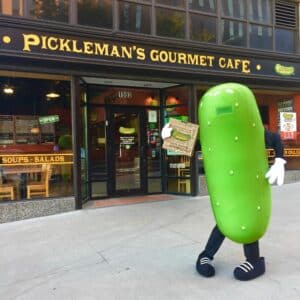
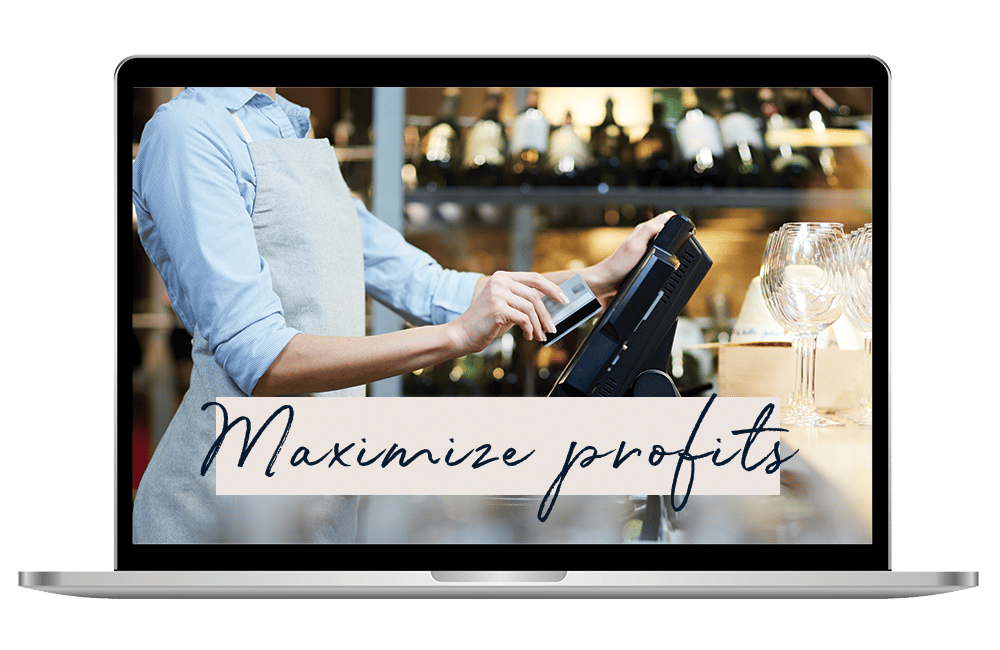
The three costly mistakes you could unknowingly be making?
Find out in this FREE guide and restaurant assessment specifically designed to reveal the unexpected hurdles standing between you and exponential business growth.
Thank You To Our Sponsors
Did You Know That 7 out of 10 Adults Dine Out To Celebrate Birthdays?
You Can Easily Capture This Lucrative Business!
For a limited time only, popmenu is offering our listeners $100 off your first month plus an unchanging lifetime rate.
Request a DEMO:
Want to become a podcast sponsor?
Please get in touch with Roger at roger@restaurantrockstars.com
